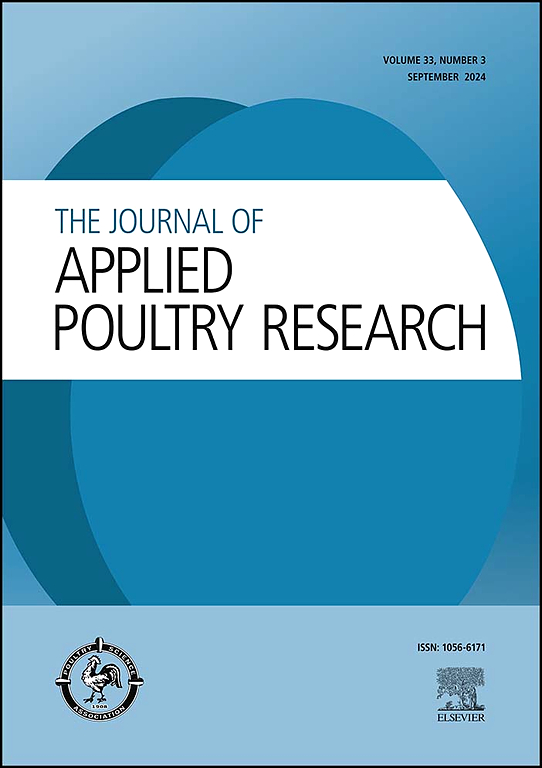Assessing soybean processing add-backs in soybean meal via a dietary broiler performance test
IF 2
3区 农林科学
Q2 AGRICULTURE, DAIRY & ANIMAL SCIENCE
引用次数: 0
Abstract
This experiment assessed the feeding value of soybean meal with the inclusion of soybean crush plant “add-backs” ingredients (i.e. gums and soapstocks) in Cobb MX x 500 male broilers from 0 to 45 d of age. Five corn and soy-based diets were formulated with soybean meal containing various levels of soybean gums and soapstocks inclusions or the addition of an inert filler. Diet 1 contained soybean meal with no add-backs whereas diets 2 through 5 contained either 4 % gums, 4 % soapstocks, 2 % gums and 2 % soapstocks, or 4 % inert filler, respectively. Diets were fed to 1,200 male broilers across 10 replicate treatment pens of 24 birds in a randomized complete block design. Birds were weighed at d 0, 14, 28, and 45 and live performance was assessed from the 0 to 45 d period. After each weigh period, one bird per pen was selected for body composition analysis using dual x-ray absorptiometry. Additionally at d 45, one bird per pen was selected for assessment of gut integrity. Six birds per pen were evaluated for carcass characteristics at d 45. Diet 1 had significantly higher FCR from 0 to 45 d than treatments 2 through 5. No significant responses were observed for most live performance measurements, carcass yields, gut integrity, or woody breast measurements. In conclusion, soybean gums and soapstocks added back to soybean meal can be fed to broilers without loss in performance.
通过饲粮肉鸡生产性能试验评估豆粕中大豆加工添加量
本试验评估了在0 ~ 45日龄Cobb MX x 500雄性肉鸡中添加大豆压榨植物“添加剂”成分(即树胶和皂粕)的豆粕的饲用价值。用豆粕配制了5种以玉米和大豆为基础的饲粮,其中豆粕含有不同水平的大豆胶和皂粕夹杂物或添加惰性填料。饲粮1含有豆粕,不添加添加剂,而饲粮2至5分别含有4%树胶、4%皂粕、2%树胶和2%皂粕或4%惰性填料。采用完全随机区组设计,在24只鸡的10个重复处理栏中对1200只雄性肉鸡饲喂饲粮。分别于第0、14、28和45 d称重,并在第0 ~ 45 d期间评价活产性能。每个称重期结束后,每栏选取一只雏鸟,采用双x射线吸收仪进行体成分分析。此外,在第45天,每栏选择一只鸟进行肠道完整性评估。45 d时,对每栏6只鸡的胴体性状进行评价。饲料1 0 ~ 45 d的饲料转化率显著高于处理2 ~ 5。在大多数活产性能测量、胴体产量、肠道完整性或木质乳房测量中均未观察到显著的反应。综上所述,在豆粕中添加大豆胶和皂粕可在不影响肉鸡生产性能的情况下饲喂肉鸡。
本文章由计算机程序翻译,如有差异,请以英文原文为准。
求助全文
约1分钟内获得全文
求助全文
来源期刊

Journal of Applied Poultry Research
农林科学-奶制品与动物科学
CiteScore
4.10
自引率
10.50%
发文量
80
审稿时长
104 days
期刊介绍:
The Journal of Applied Poultry Research (JAPR) publishes original research reports, field reports, and reviews on breeding, hatching, health and disease, layer management, meat bird processing and products, meat bird management, microbiology, food safety, nutrition, environment, sanitation, welfare, and economics. As of January 2020, JAPR will become an Open Access journal with no subscription charges, meaning authors who publish here can make their research immediately, permanently, and freely accessible worldwide while retaining copyright to their work. Papers submitted for publication after October 1, 2019 will be published as Open Access papers.
The readers of JAPR are in education, extension, industry, and government, including research, teaching, administration, veterinary medicine, management, production, quality assurance, product development, and technical services. Nutritionists, breeder flock supervisors, production managers, microbiologists, laboratory personnel, food safety and sanitation managers, poultry processing managers, feed manufacturers, and egg producers use JAPR to keep up with current applied poultry research.
 求助内容:
求助内容: 应助结果提醒方式:
应助结果提醒方式:


